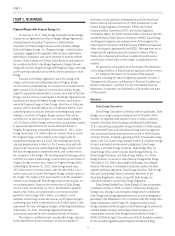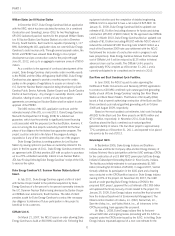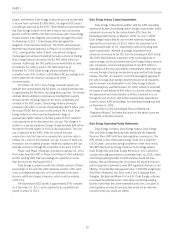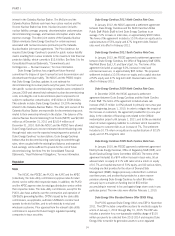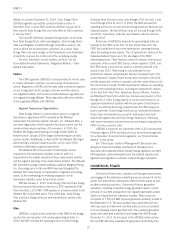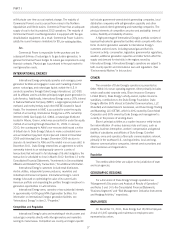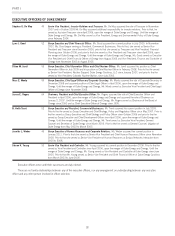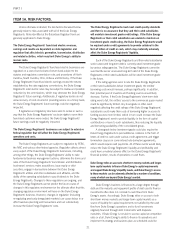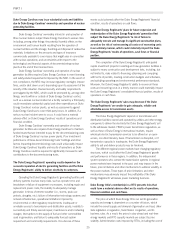Duke Energy 2011 Annual Report Download - page 35
Download and view the complete annual report
Please find page 35 of the 2011 Duke Energy annual report below. You can navigate through the pages in the report by either clicking on the pages listed below, or by using the keyword search tool below to find specific information within the annual report.
PART I
affiliate on or before December 31, 2014. Duke Energy Ohio’s
USFE&G segment successfully conducted initial auctions in
December 2011 to serve SSO customers effective January 2012.
New rates for Duke Energy Ohio went into effect for SSO customers
in January 2012.
The new ESP effectively separates the generation of electricity
from Duke Energy Ohio’s retail load obligation. Duke Energy Ohio’s
retail load obligation is satisfied through competitive auctions, the
costs of which are recovered from customers. As a result, Duke
Energy Ohio now earns margin on the transmission and distribution
of electricity only and not on the cost of the underlying energy.
For more information on rate matters, see Note 4 to the
Consolidated Financial Statements, “Regulatory Matters — Rate
Related Information.”
Federal
The FERC approves USFE&G’s cost-based rates for electric sales
to certain wholesale customers, as well as sales of transmission
service. Regulations of FERC and the state utility commissions govern
access to regulated electric and gas customer and other data by
non-regulated entities, and services provided between regulated and
non-regulated energy affiliates. These regulations affect the activities
of non-regulated affiliates with USFE&G.
Regional Transmission Organizations.
Duke Energy Indiana is a transmission owner in a regional
transmission organization (RTO) operated by the Midwest
Independent Transmission System Operator, Inc. (Midwest ISO), a
non-profit organization which maintains functional control over the
combined transmission systems of its members. In 2005, the
Midwest ISO began administering an energy market within its
footprint and in January 2009 it began administering an ancillary
services market. Additionally, in April 2009, the Midwest ISO began
administering a voluntary capacity auction, and in June 2009,
instituted a tariff based capacity requirement.
The Midwest ISO is the provider of transmission service
requested on the transmission facilities under its tariff. It is
responsible for the reliable operation of those transmission facilities
and the regional planning of new transmission facilities. The Midwest
ISO administers energy markets utilizing Locational Marginal Pricing
(i.e.,theenergypriceforthenextMWmayvarythroughoutthe
Midwest ISO market based on transmission congestion and energy
losses) as the methodology for relieving congestion on the
transmission facilities under its functional control.
Effective January 1, 2012, Duke Energy Ohio and Duke Energy
Kentucky became transmission owners in a RTO operated by PJM
Interconnection, LLC (PJM). PJM operates in a manner similar to the
Midwest ISO as described above. Prior to this date, Duke Energy
Ohio and Duke Energy Kentucky were transmission owners in the
Midwest ISO.
Other
USFE&G is subject to the jurisdiction of the NRC for the design,
construction and operation of its nuclear generating facilities. In
2000, the NRC renewed the operating license for Duke Energy
Carolinas’ three Oconee nuclear units through 2033 for Units 1 and
2 and through 2034 for Unit 3. In 2003, the NRC renewed the
operating licenses for all units at Duke Energy Carolinas’ McGuire and
Catawba stations. The two McGuire units are licensed through 2041
and 2043, respectively, while the two Catawba units are licensed
through 2043.
All but one of USFE&G’s hydroelectric generating facilities are
licensed by the FERC under Part I of the Federal Power Act. The
FERC has jurisdiction to issue new hydroelectric operating licenses
when the existing license expires. The 13 hydroelectric stations of the
Catawba-Wateree Project are in the late stages of the FERC
relicensing process. These stations continue to operate under annual
extensions of the current FERC license, which expired in 2008, until
the FERC issues a new license, which is currently projected to be
issued in late 2012. Relicensing is now underway for two
hydroelectric stations comprising the Keowee-Toxaway Project. The
current Keowee-Toxaway Project license does not expire until 2016
and the project will continue to operate under the current license until
the new license is issued. All other hydroelectric stations are operating
under current operating licenses, including ten hydroelectric stations
(in the East Fork, West Fork, Nantahala, Bryson, Mission, Franklin,
and Markland Projects) for which new licenses were issued in 2010
through 2012. Duke Energy expects to receive new licenses for all
applicable hydroelectric facilities with the exception of the Dillsboro
Project, for which Duke Energy requested and the FERC approved
license surrender. Duke Energy Carolinas has removed the Dillsboro
Project dam and powerhouse as part of multi-project and multi-
stakeholder agreements and Duke Energy Carolinas is continuing
with stream restoration and post-removal monitoring as requested by
FERC’s license surrender order.
USFE&G is subject to the jurisdiction of the U.S. Environmental
Protection Agency (EPA) and state and local environmental agencies.
For a discussion of environmental regulation, see “Environmental
Matters” in this section.
See “Other Issues” section of Management’s Discussion and
Analysis of Financial Condition and Results of Operations for a
discussion about potential Global Climate Change legislation and other
EPA regulations under development and the potential impacts such
legislation and regulation could have on Duke Energy’s operations.
COMMERCIAL POWER
Commercial Power owns, operates and manages power plants
and engages in the wholesale marketing and procurement of electric
power, fuel and emission allowances related to these plants as well
as other contractual positions. Commercial Power’s generation
operations, excluding renewable energy generation assets, consist
primarily of coal-fired and gas-fired non-regulated generation assets
which are dispatched into wholesale markets. These assets are
comprised of 7,550 net MW of power generation primarily located in
the Midwestern U.S. The asset portfolio has a diversified fuel mix
with base-load and mid-merit coal-fired units as well as combined
cycle and peaking natural gas-fired units. The coal-fired generation
assets were dedicated under the Duke Energy Ohio ESP through
December 31, 2011. As discussed in the USFE&G section above,
the new ESP effectively separates the generation of electricity from
15


